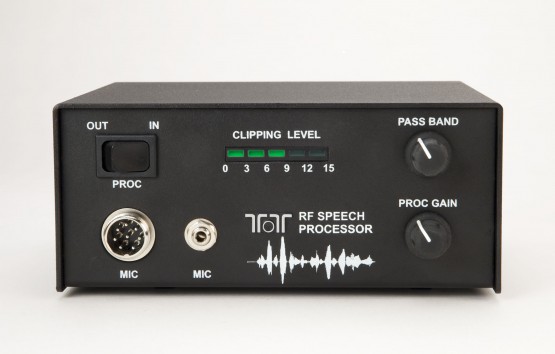 Model 715 RF Speech Processor is a high performance true RF-type speech processor designed to operate with most modern HF Amateur Radio transceivers. RF speech processing is a superior system to the traditional AF clipping, AF compression, or RF compression found in a typical HF transceiver for achieving the highest ratio of average-to-peak power from an SSB transmitter.
Model 715 RF Speech Processor is a high performance true RF-type speech processor designed to operate with most modern HF Amateur Radio transceivers. RF speech processing is a superior system to the traditional AF clipping, AF compression, or RF compression found in a typical HF transceiver for achieving the highest ratio of average-to-peak power from an SSB transmitter.
- Increase average SSB power output by up to 6 dB
- Enhance readability by stations hearing your signal
- Break pileups for DXpeditions faster
- Keep your net or contest run frequency clearer
- Easy to install, easy to operate
The purpose of an RF speech processor is to increase the readability of your signal at the other end of a QSO. Speech processors do not increase peak power; they increase average power output. An up to 6 dB increase in average power output in SSB service can be achieved with the proper use of a true RF speech processor like Ten-Tec model 715.
This power increase, coupled with the ability to tailor the speech passband can mean the difference between a signal buried under band noise or an intelligible, copyable signal.
The 715 RF speech processor is installed between the microphone and the microphone jack on your transceiver. Two inputs for microphones are provided. A conventional 8 pin microphone connector that is wired the same as the 8 pin microphone input on the Omni-VII and Orion II transceivers (also wired the same as 8 pin Yaesu connectors), and a second 1/8” input used for direct connection of microphones or headsets like Heil Sound, etc. The output connector is a 1/4” stereo connector. Output cables are available for 4 pin Ten-Tec, 8 pin Ten-Tec (also used by Yaesu), 8 pin Kenwood (also used by Elecraft), 8 pin Icom.
An input adapter, model 720, is now available for plugging Icom microphones directly into the front of the 715. A Kenwood/Elecraft adapter, model 721, will be available in the near future.
AF clipping or compression processors found in a typical HF transceiver typically create distortion consisting of harmonics and IMD products. An RF speech processing system converts the input audio signal to an RF SSB signal. It is then clipped, fed through a ceramic filter and returned to audio, effectively removing harmonic distortion that would have been present in an AF system.
Model 715 takes the input audio signal, converts to a 455 kHz DSB signal, removes the opposite sideband and limits distortion products with filtering before returning the resulting signal back to audio for output to your transceiver.
Why use an RF speech processor? Several reasons, all related to signal copyability. The increase in average power output between a non-processed and a processed signal under marginal band conditions can be enough to make the difference between being heard and not being heard. During DXpeditions or contests, the goal is to be heard before everyone else or through a pileup. Maximizing average power output whether you are running barefoot or using an external linear amplifier is a paramount consideration. Why not take full advantage of the allowable legal maximum power output? Much of average power is lost as high amplitude, low energy voice peaks. Increasing average power by a few dB is like having an extra amplifier or a better antenna available than what you are currently using.
Small footprint ensures valuable desk space is not taken over by the unit — measures only 2.5” H x 6.0” W x 5.0” D. Weight 1..25 lbs.
The model 715 RF Speech Processor is priced at $249 plus shipping and is in stock and available now. $249 includes one output cable of your choice, 4 pin Ten-Tec, 8 pin Ten-Tec (also used by Yaesu), 8 pin Kenwood (also used by Elecraft), 8 pin Icom. Additional output cables are available at only $35 each.
